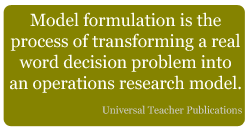Linear Programming Model Formulation
In fact, the most difficult problem in the application of management science is formulation.
Therefore, it is important to consider linear programming model formulation before launching into the details of linear programming (LP) solution.
Model formulation is the process of transforming a real word decision problem into an operations research model. In the sections that follow, we give several Lilliputian examples so that you can acquire some experience.
All the examples that we provide in the following sections are of static models, because they deal with decisions that occur only within a single time period.

In product mix selection, the decision-maker strives to determine the combination of the products, which will maximize the profit without violating the resource constraints. In the instance below, the objective is to maximize the profit. In the subsequent examples, you will see other objectives, such as minimum cost.
Examples of Linear Programming Model Formulation
 Example 1
Example 1
Universal Corporation manufactures two products- P1 and P2. The profit per unit of the two products is Rs. 50 and Rs. 60 respectively. Both the products require processing in three machines. The following table indicates the available machine hours per week and the time required on each machine for one unit of P1 and P2. Formulate this product mix problem in the linear programming form.
| Machine | Product | Available Time (in machine hours per week) |
|
| P1 | P2 | ||
| 1 | 2 | 1 | 300 |
| 2 | 3 | 4 | 509 |
| 3 | 4 | 7 | 812 |
| Profit | Rs. 50 | Rs. 60 | |
Solution.
Let x1 and x2 be the amounts manufactured of products P1 and P2 respectively. The objective here is to maximize the profit, which is given by the linear function
Maximize z = 50x1 + 60x2
Since one unit of product P1 requires two hours of processing
in machine 1, while the corresponding requirement of P2 is
one hour, the first constraint can be expressed as
2x1 + x2 ≤ 300
Similarly, constraints corresponding to machine 2 and machine 3 are
3x1 + 4x2 ≤ 509
4x1 + 7x2 ≤ 812
In addition, there cannot be any negative production
that may be stated algebraically as
x1 ≥ 0, x2 ≥
0
The problem can now be stated in the standard linear programming form as
Maximize z = 50x1 + 60x2
subject to
2x1 + x2 ≤ 300
3x1 + 4x2 ≤ 509
4x1 + 7x2 ≤ 812
x1 ≥ 0, x2 ≥ 0
Key Assumptions in Mathematical LP Formulation
Additivity. The total amounts of each input and the corresponding profit are the sums of the inputs and profit for each individual process. For example, one unit of Product 1 and one unit of Product 2 require 3 (2 + 1) hours of processing in machine 1, 7 (3 + 4) hours of processing in machine 2, 11 (4 + 7) hours of processing in machine 3, and yield Rs.110 (50 + 60) profit.
Divisibility. The activity levels are allowed to assume fractional values as well as integer values. For example, we admit the possibility of x1 = 509/3 or 169.67, x2 = 509/4 or 127.25.
Proportionality. The total amounts of each input and the associated profit are directly proportional to the level of output.
For example, to manufacture 1 unit of product 1 (x1 = 1), we require 2 hours of processing in machine 1, 3 hours of processing in machine 2, 4 hours of processing in machine 3, and the profit is Rs.50. By the same token, to manufacture 10 units of product 1 (x1 = 10), we require 20 hours of processing in machine 1, 30 hours of processing in machine 2, 40 hours of processing in machine 3, and the profit is Rs.500.
For all the examples in the subsequent sections of this chapter, we assume these assumptions to hold good.
Packaging Problem
The Best Stuffing Company manufactures two types of packing tins- round & flat. Major production facilities involved are cutting and joining. The cutting department can process 200 round tins or 400 flat tins per hour. The joining department can process 400 round tins or 200 flat tins per hour. If the contribution towards profit for a round tin is the same as that of a flat tin, what is the optimal production level? Formulate a linear programming model for this problem (LPP).
Solution.
Let
x1 = number of round tins per hour
x2 = number of flat tins per hour
Since the contribution towards profit is identical for both the products, the objective function can be expressed as x1 + x2. Hence, the problem can be formulated as
Maximize Z = x1 + x2
subject to
(1/200)x1 + (1/400)x2 ≤
1
(1/400)x1 + (1/200)x2 ≤
1
x1 ≥ 0, x2 ≥ 0
i.e., 2x1 + x2 ≤
400
x1 + 2x2 ≤ 400
x1 ≥ 0, x2 ≥ 0
By studying the above linear programming model examples and answering the exercises given at the end of this chapter, you will get good experience of LP formulation.



